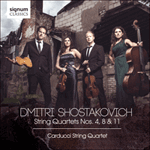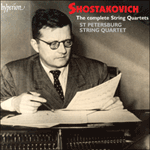
Welcome to Hyperion Records, a British classical label devoted to presenting high-quality recordings of music of all styles and from all periods from the twelfth century to the twenty-first.
Hyperion offers both CDs, and downloads in a number of formats. The site is also available in several languages.
Please use the dropdown buttons to set your preferred options, or use the checkbox to accept the defaults.

| Carducci String Quartet» More |
The emotion is almost too direct. We know that in his dedication of the score to the ‘memory of the victims of fascism and war’, Shostakovich included himself as a victim, and that, regarding this as his last work, he planned to commit suicide after being forced to join the Communist Party. The extensive self-quotation in the Eighth Quartet is thereby explained, as is the directness of the emotional content, but such was the composer’s inherent creative genius that all of these myriad elements are combined with extraordinary thematic integration and cohesion.
This unity is derived from the opening four-note cell, DSCH (the composer’s own thematic monogram in German—D, E flat, C, B) occasionally encountered in his post-war music, but never more so than here. The quartet also quotes from his First, Fourth, Tenth and Eleventh Symphonies, the Piano Trio No 2, the First Cello Concerto, the banned opera Lady Macbeth of Mtsensk, and a song well-known in Russia, Exhausted by the hardships of prison. After the quartet was composed, and after overcoming his suicidal mood, Shostakovich began revising the opera as Katerina Ismailova, Op 114. The quartet’s underlying tonal scheme, as so often with this composer, echoes the work’s emotionally direct thematicism; in terms of broad outlines, the first movement is in C minor, the second—diametrically opposed—is in G sharp minor; the tonality falls semitonally to G minor for the third movement, and the fourth is likewise diametrically opposed, in C sharp minor. This falls, semitonally, to the C minor of the opening tonality to conclude the work.
The first movement begins with the DSCH motif, in the cello. The quartet is, clearly, to be a personal statement by the composer. The motif unfolds as a slow canonic exposition before three further ideas follow: the (very slow) quotation of the opening of the First Symphony, a descending chromatic scale over a long-held pedal bare fifth, and a theme akin to the second subject of the Fifth Symphony’s first movement. This material is counter-stated, but in reverse order, before—attacca—the fierce second movement, ‘Allegro molto’, shatters the fabric of the music.
This dramatic movement is propelled by a driving, impatient rhythm taken from the ‘Fifth Symphony’ theme and combined with DSCH in octave canon. The drive and impetus of the music is incessant, increasing in intensity until a great climax brings the wry ‘Piano Trio’ theme, now fff, and the material is recapitulated, the registers altered, and building to a considerable climax. This is suddenly severed and succeeded by a sardonic waltz structure, introduced by DSCH high on the first violin.
This waltz has an obsessed, hauntingly troubled nature, stemming from DSCH and the descending chromatic scale; the movement’s second main theme is passionate and vibrant, and, suddenly, the pulse becomes 2/2 with the appearance of the opening theme of the First Cello Concerto—but not on the cello. Almost at once this is gone, and the cello itself now has a high lyrical theme leading to a counterstatement of the material—the cello’s theme replaced by an extended unaccompanied violin line whose drone-like A sharp is sustained against clustered ‘gunfire’ from the lower strings. This is in fact the ‘Cello Concerto’ theme in massive augmentation, which leads to a deeply moving stream of music created from fragments of (among others) the Tenth and Eleventh Symphonies, DSCH, the revolutionary song and Lady Macbeth. The first violin, which began the movement, closes it with a new statement of the ever-present, all-observing, DSCH motif, expanding in slow fugal texture more fully worked than in the first movement, principally owing to a berceuse-like countersubject in the major, and which, as it progresses, slowly winds the music down to the C minor of DSCH, and thus finally lays this deeply disturbing score to rest.
from notes by Robert Matthew-Walker © 2000
Cette unité découle de la cellule d’ouverture de quatre notes, DSCH (le monogramme thématique du compositeur, en allemand: ré, mi bémol, ut, si), que l’on rencontre parfois dans la musique composée après la guerre, mais jamais autant qu’ici. Cette pièce cite également les Première, Quatrième, Dixième et Onzième symphonies, le Trio avec piano no2, le Premier concerto pour violoncelle et l’opéra interdit Lady Macbeth de Mtsensk—la composition du Huitième quatuor coïncida avec la révision de cet opéra sous le titre Katerina Ismaïlova, op.114. Comme si souvent chez Chostakovitch, le schéma tonal sous-jacent du Quatuor fait écho au thématisme émotionnellement direct de l’œuvre; grosso modo, le premier mouvement est en ut mineur et le deuxième, diamétralement opposé, en sol dièse mineur; puis, la tonalité chute semi-tonalement jusqu’à sol mineur pour le troisième mouvement, cependant que le quatrième (lui aussi diamétralement opposé) est en ut dièse mineur. La tonalité chute alors semi-tonalement jusqu’à l’ut mineur d’ouverture pour conclure l’œuvre.
Le premier mouvement débute par le motif DSCH, au violoncelle: le Quatuor sera, à l’évidence, une énonciation personnelle du compositeur. Le motif s’éploie sous les dehors d’une lente exposition canonique, suivie de trois idées: primo, la (très lente) citation de l’ouverture de la Première symphonie; secundo, une gamme chromatique descendante, par-dessus une pédale de simple quinte tenue; tertio, un thème affilié au second sujet du premier mouvement de la Cinquième symphonie. Ce matériau est contre-énoncé, en ordre inverse, avant que—attacca—le féroce deuxième mouvement, «Allegro molto», ne fracasse la trame de la musique.
Ce mouvement dramatique est propulsé par un rythme allant, impatient, emprunté au thème de la Cinquième symphonie et combiné à DSCH dans un canon à l’octave. Le dynamisme et l’élan de cette musique ne cessent de gagner en intensité jusqu’à ce qu’un grand apogée amène le thème désabusé du Trio avec piano (désormais fff) et que le matériau soit repris, que les registres soient altérés, aboutissant à un immense point culminant soudain rompu et suivi d’une sardonique structure de valse, introduite par DSCH, joué aigu au premier violon.
Cette valse possède une nature obsédante, d’un trouble entêtant, qui prend naissance dans DSCH et la gamme chromatique descendante; le second thème principal du mouvement est passionné et vibrant quand, soudain, le mètre passe à 2/2, avec l’apparition du thème d’ouverture du Premier concerto pour violoncelle—mais non exécuté au violoncelle. Ce thème s’en va presque immédiatement, et le violoncelle se voit confier un thème lyrique aigu, menant à une contre-énonciation du matériau—le thème violoncellistique est remplacé par une vaste ligne violonistique sans accompagnement, dont le la dièse bourdonnant est tenu contre une «fusillade» décochée par les cordes inférieures. Il s’agit en réalité du thème du Concerto pour violoncelle, en augmentation massive, qui conduit à un torrent musical profondément émouvant créé à partir de fragments de diverses œuvres (dont les Dixième et Onzième symphonies), de DSCH, du chant révolutionnaire En prison et de Lady Macbeth. Le premier violon, qui ouvrait le mouvement, le ferme avec une nouvelle énonciation du motif DSCH, omniprésent et «omnivoyant», qui se prolonge sous la forme d’une lente texture fuguée, plus pleinement travaillée que dans le premier mouvement et essentiellement redevable à un contre-sujet de type berceuse en majeur—et qui, en progressant, fait lentement redescendre la musique à l’ut mineur de DSCH pour finalement laisser ainsi reposer cette partition profondément troublante.
extrait des notes rédigées par Robert Matthew-Walker © 2000
Français: Hypérion
Diese Einheit geht auf die einleitende, aus vier Noten bestehende Zelle DSCH zurück (das thematische Monogramm des Komponisten: D, Es, C, H), der man gelegentlich in seiner Nachkriegsmusik begegnet, aber nie so oft wie hier. Darüber hinaus zitiert das Quartett Auszüge aus seiner Ersten, Vierten, Zehnten und Elften Sinfonie, aus dem Klaviertrio Nr. 2, dem ersten Cellokonzert und der verbotenen Oper Lady Macbeth von Mzensk. Um die Zeit, als das Quartett komponiert wurde, war Schostakowitsch soeben dabei, die Oper unter dem Titel Katerina Ismailowa Op. 114 zu überarbeiten. Das tonale Grundschema des Quartetts läßt, wie es bei diesem Komponisten häufig der Fall ist, die emotional direkt wirkende Thematik des Werks anklingen; im Großen und Ganzen steht der erste Satz in c-Moll, der zweite—genau entgegengesetzt—in gis-Moll; die Tonalität fällt für den dritten Satz in Halbtonschritten nach g-Moll ab, und der vierte ist wiederum diametral entgegengesetzt in cis-Moll gehalten. Es folgt ein Abstieg um einen halben Ton zum c-Moll der einleitenden Tonalität, der das Werk zum Abschluß bringt.
Der erste Satz beginnt mit dem DSCH-Motiv auf dem Cello. Das Quartett ist eindeutig als persönliche Aussage des Komponisten gedacht. Das Motiv entfaltet sich als langsame kanonische Exposition, ehe drei weitere Motive anschließen: das (sehr langsame) Zitat aus der Eröffnung der Ersten Sinfonie, eine abwärts gerichtete chromatische Tonleiter über einem lang ausgehaltenen Orgelpunkt auf der leeren Quinte und ein Thema ähnlich dem Seitenthema aus dem ersten Satz der Fünften Sinfonie. Dieses Material wird in umgekehrter Reihenfolge einer erneuten Exposition unterworfen, und dann zerreißt—attacca—der ungestüme zweite Satz mit der Bezeichnung „Allegro molto“ das Gewebe der Musik.
Dieser dramatische Satz wird von einem peitschenden, ungeduldigen Rhythmus vorangetrieben, der aus dem „Thema der Fünften“ hervorgegangen ist und mit DSCH in oktavischem Kanon kombiniert wird. Die Triebkraft dieser Musik ist unermüdlich und steigert sich von der Intensität her, bis ein mächtiger Höhepunkt das ironische Thema aus dem Klaviertrio fff darbietet und das Material mit verändertem Register und unter Aufbau eines weiteren beachtlichen Höhepunkts einer Reprise unterzogen wird. Diese bricht plötzlich ab, und an ihre Stelle tritt eine vom DSCH hoch auf der Primgeige eingeführte sardonische Walzerpassage.
Der Walzer hat einen zwanghaften, bedrückend unruhigen Charakter, der auf das DSCH und die absteigende chromatische Tonleiter zurückzuführen ist; das zweite Hauptthema des Satzes ist leidenschaftlich und lebhaft, und dann wechselt mit dem Auftreten des Eröffnungsthemas aus dem Ersten Cellokonzert—das jedoch nicht vom Cello gespielt wird—der Takt nach 2/2 über. Damit ist es beinahe sofort wieder vorbei, und das Cello trägt ein hohes lyrisches Thema vor, das zur erneuten Exposition des Materials führt—das Cellothema wird durch eine lange unbegleitete Violinlinie ersetzt, deren bordunartiges Ais gegen die geballten „Salven“ der tieferen Streicher durchgehalten wird. Diese Linie ist in Wahrheit das Thema aus dem Cellokonzert in massiver Vergrößerung und mündet in einen zutiefst bewegenden Strom von Musik, der sich (unter anderem) aus Fragmenten der Zehnten und Elften Sinfonie, des DSCH, eines revolutionären Liedes mit dem Titel Im Kerker und der Oper Lady Macbeth zusammensetzt. Die Primgeige, die den Satz begonnen hat, beschließt ihn mit einer erneuten Darbietung des allgegenwärtigen, alles überwachenden DSCH-Motivs. Dieses weitet sich zur langsamen fugalen Struktur aus, die stärker als im ersten Satz durchgeführt ist, was in erster Linie einem im Berceuse-Stil gehaltenen Kontrasubjekt in Dur zu verdanken ist, drosselt im weiteren Verlauf die Musik zum c-Moll von DSCH und bettet dieses zutiefst beunruhigende Stück somit endlich zur Ruhe.
aus dem Begleittext von Robert Matthew-Walker © 2000
Deutsch: Anne Steeb/Bernd Müller
 Shostakovich: String Quartets Nos 4, 8 & 11 Shostakovich: String Quartets Nos 4, 8 & 11The Carducci Quartet is recognized as one of today’s most successful string quartets. Here they present three of Shostakovich's fifteen quartets, including the powerful No 8.» More |
 Shostakovich: The Complete String Quartets Shostakovich: The Complete String Quartets‘These players approach Shostakovich's mighty cycle with a natural authority that's unanswerable, along with tireless precision and virtuosity, plus a ... ‘The St Petersburg musicians play with tremendous control of technique and expression; the effect is one of huge emotional strength’ (Birmingham Post)» More |

